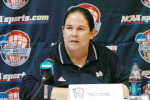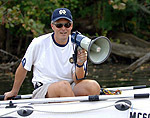Oct. 5, 2006
By Ken Kleppel
Understanding the importance of opportunities for women in athletics must surely have hit close to home for Notre Dame’s past three athletic directors, Dick Rosenthal (1987 to 1995), the late Mike Wadsworth (1995 to 2000), and Kevin White (2000 to present).
A parent before any other title–Rosenthal was the father of six daughters, Wadsworth the father of three, and White the father of two–certainly all three Directors acknowledged the influence of athletics on the development of women both on the field of play and away from it.
If nothing else, the continued promotion and advancement of women’s athletics at Notre Dame during their watch would seem to indicate so. Within his first four years on the job, Rosenthal added 31 women’s scholarships and created four women’s varsity sports–soccer (1988), golf (1988), softball (1989), and track-and-field (1991). During his tenure, the Athletic Department attracted some of the most highly sought-after, up-and-coming coaches in their respective fields — Debbie Brown in volleyball and Jay Louderback in tennis, to name just a few. Under White’s leadership, women’s programs experienced unprecedented success with NCAA championships in women’s basketball (2001), fencing (2003 and 2005, in combined competition with the Irish men’s team), and women’s soccer (2004).
In between, Wadsworth created 22 additional scholarships for new and existing women’s sports and oversaw Notre Dame’s first national championship in women’s soccer as the team hoisted the trophy in 1995.
And as perhaps the biggest sign of University-wide commitment to women’s athletics during this period, in the spring of 1996, Wadsworth elevated lacrosse and rowing club teams to varsity status.
In offering the sports as the 12th and 13th women’s programs at Notre Dame, the Athletic Department had created the same number of programs for women as for men — twenty years after tennis and fencing began competition as the first varsity sports.
Throughout the entire two decades-long stretch, Deputy Athletic Director Missy Conboy, herself a former standout and captain of the Irish basketball program, helped administer the development of women’s athletics by serving in numerous capacities with the Athletic Department.
“There has been a leadership in the President’s and Athletic Director’s office to make sure that we do not give women students at Notre Dame a sub-par athletics experience,” says Conboy. “That leadership has been critical.”
Choosing the Programs to Elevate: A Look at the Process and Title IX
The selection and evaluation process formally began in 1995 as a senior staff committee of athletic directors evaluated and contacted representatives from each of the club sport teams. Personal meetings between Department staff, including Wadsworth, and representatives from the interested club teams were arranged, as interested teams completed written applications for consideration. Approval ultimately passed from the senior staff committee, to Wadsorth, and finally to Executive Vice President Father William E. Beauchamp.

The Irish varsity eight boat achieved a first in the program’s history by winning the gold medal at the Central/South Region Championships. The crew would go on to win the Petite Final at the NCAAs and finish seventh overall at the Championships in the varsity eight race.
|
In addition to lacrosse and rowing, the other primary contending club team to have its status elevated to varsity was synchronized swimming.
The applicable criteria was whether the prospective team would be able to compete immediately based on the strength of the club team already in place on campus in terms of overall talent of the athletes and organization of the club itself, whether the sport was emerging as one popularly-played nationally, and whether the team would attract student-athletes from a part of the country that Notre Dame maintained an active presence in.
Under this framework, rowing and lacrosse became the clear choices.
With lacrosse and rowing developing as emerging sports across the country, the prevailing mindset was that the program would receive a long-term boost by establishing itself as competitive in the sport’s early years. Modeling the success achieved by programs in other women’s sports, the goal was to compete at a high level quickly and then presumably dominate the sport as other programs joined the fray and needed time to develop.
In addition, both sports provided competitive opportunities for a large number of women student-athletes, especially important considering the implications of Title IX.
While colleges and universities do not necessarily need to offer identical men’s and women’s sports, the crux of Title IX mandates that female students have an equal opportunity to play in sports of interest and that the total amount of athletic aid through scholarship be substantially proportionate to the ratio of male and female student-athletes. In practice, the playing opportunities amount of scholarships awarded in both women’s lacrosse and rowing help balance the large of playing opportunities and scholarships awarded to male football players.
“There is no question that, in the late 1980s, when we started to take a look at the addition of women’s programs, Title IX was a motivating factor–it helped push the agenda,” says Conboy. “But, in adding lacrosse and rowing, we were trying to do the right thing and not just because we had to obey rules.”
The plan has worked wonders. Ten years later, both sports finished ranked as top-10 teams in 2006. Additionally, rowing and lacrosse have provided opportunities for women by utilizing rosters of 58 and 28, respectively.
The First Season and Overcoming Regional Biases
Both programs began competition within one academic year after acquiring varsity status–lacrosse in the spring of 1997 and rowing in the fall of 1998. And still presiding in the head coach’s chair are the same individuals that took the helm on day one–Tracy Coyne in lacrosse and Martin Stone in rowing.

Notre Dame’s women’s lacrosse team made its first-ever NCAA final four appearance in 2006 at Boston University’s Nickerson Field. In 10 seasons as a Division I program, women’s lacrosse has participated in three NCAA tournaments (2002, 2004 and ’06).
|
Coyne was hired in July 1997 and, along with assistant coaches Kristen Wagner and Liz (Downing) Monte, began work from her office in Gate Eight of the Joyce Center in mid-August of that year.
Notre Dame opened its first season with an 18-11 win against Fairfield in Ashland, Va., on March 12, 1997 and finished with a winning record in that maiden campaign.
“I don’t think I realized how difficult it would be to build the program,” says Coyne. “We thought it was a natural fit because of the successful club team we had on campus, but because lacrosse is so much of a regional sport is was a challenge at first to get certain players to consider us.”
Competing in a sport historically dominated by programs in the Northeast posed challenges in recruiting and scheduling.
“In the beginning we had kids that were hard workers and that came in with a vision of building the program,” says Coyne. “They were able to establish women’s lacrosse as it is today.”
As the number of All-Americans on the roster increased, so did the number of nationally-ranked teams on the schedule. Coupled with the development of Northwestern as a dominant program, Coyne helped establish college women’s lacrosse in the Midwest.
Martin Stone and rowing undertook a similar path in the face of similar biases.
Stone was named head coach in October 1997, a full year before the program began competition in the fall of 1998, and in his first season was assisted by coaches Kevin Luecke and Kerry O’Keefe.
Stone scheduled the best teams in the Midwest, and then around the country, to build one of the most competitive schedules in the nation at the time.
“Our kids have expectations that they want the test to become the best in the country,” says Stone. “Better competition brings the best out of your team.”

. Tracy Coyne (seen at an NCAA press conference) is the only coach in the Notre Dame women’s lacrosse program’s history. In 10 seasons, her teams are 87-64 and have advanced to the NCAA tournament three times.
|
His program experienced immediate success. In the first season, the lightweight boat finished the season ranked twelfth in the nation after finishing third at the Midwest Championships. The varsity eight and the novice eight boats also made strong showings at the Georgetown Invitational, finishing fourth and eighth, respectively. The novice eight also finished second at the Midwest Championships.
“The goal is to win a national championship and finish in the top five regularly,” says Stone. “Anything less that that would be a disappointment.”
With the groundwork established, both programs excel today.
Long-term Success and Record Seasons in 2005-06
Over the course of its brief ten-year history, lacrosse has compiled an 87-64 record with three trips to the NCAA Tournament (2002, 2004, 2006), produced 10 All-American players, including its first two-time All-American Crysti Foote in 2006, and achieved a berth in the national semi-finals (2006). In 2006 the program engineered the largest turnaround in NCAA Division I women’s lacrosse history by rebounding from a 3-12 season in 2005 to a 15-4 finish and advancing to the Final Four. The team finished seventh in the Intercollegiate Women’s Lacrosse Coaches Association (IWLCA) poll, equaling the highest ranking in program history.
Coyne’s coaching acumen mirrors the growth of the program. A two-time BIG EAST coach of the year (2004 and 2006) and IWLCA Division I national coach of the year (2006), Coyne has served as Canada’s national team coach since 1999 in leading Team Canada to fourth-place finishes at the 2001 and 2005 World Cups.

Notre Dame’s rowing program has been under the guidance of coach Martin Stone since 1997. In 2006, the Irish won their third consecutive BIG EAST rowing title and advanced to the NCAA team championships for the first time. In 2002 and 2004, the varsity eight boat competed as at-large qualifiers.
|
Rowing also enjoyed its best season in 2005-06. In just its eighth year as a varsity program, rowing earned its first-ever NCAA Championships appearance in team competition en route to winning its third consecutive BIG EAST title. The Irish had made appearances in the varsity eight competition in both 2002 and 2004 as at-large qualifiers, but `06 was the first time in which the varsity eight, second varsity eight, and varsity four competed at the event as a team.
Beginning the season unranked, the varsity eight boat finished ninth as a team at the NCAA Championships and fifth in the final Collegiate Rowing Coaches Association (CRCA)/US Rowing Poll. The team won four of six races and accumulated a record point total of 122 points.
Stone was honored as the Division I Central Region, CRCA, and BIG EAST coach of the year in 2006. A record three rowers — senior Sarah Palandech and sophomores Amanda Polk and Julie Soboleski — earned CRCA All-American honors as members of the record-setting varsity eight boat.
“A large part of our success is the success of the University itself,” says Stone. “The expectation of Notre Dame students is to put forth great effort and excel in the classroom. That mindset carries over to athletics. The academic and athletic tradition here goes hand-in-hand with each other.”
The Next Chapter
In the fall of 2001, Athletic Director Kevin White announced that both sports would receive the full allotment of scholarships permitted by the NCAA by the 2004-05 academic year meaning that lacrosse and rowing award 12 and 20 full scholarships per season, respectively.
“Twenty years ago we did what we had to do,” says Conboy. “Today we do what we want to do to promote fairness.”
Notre Dame’s commitment to the growth of women’s sports on campus remains unwavering as the University continues to face the challenges of maintaining successful women’s athletic programs over the course of the next two decades of women’s athletics.
“The University did a lot to set itself apart,” says Coyne. “It is one thing to say something but another to back it up. Kevin White and the Athletic Department inspired us and gave us the resources to go after it.”
Coyne and Stone will one day get their championship, and join soccer, basketball, and fencing as national champion women’s sports.
And, while doing so, they will continue to take these ideals to the homes of their staffs, student-athletes, and recruits.
Inside the home. Just where it all may have started.







